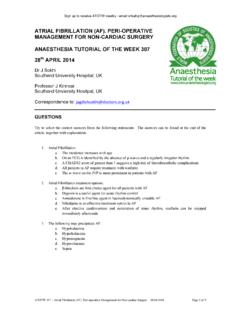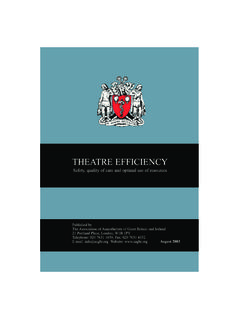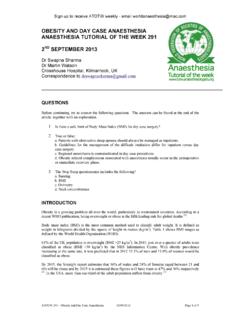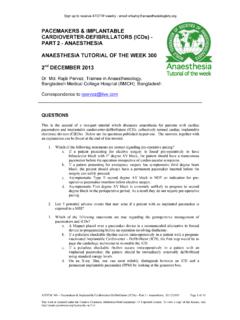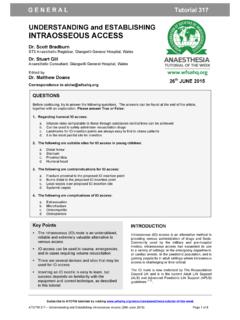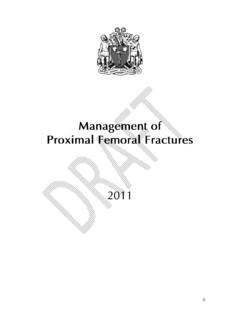Transcription of 325 WHO Surgical Safety Checklist - AAGBI
1 Subscribe to ATOTW tutorials by visiting ATOTW 325 who surgical safety checklist (5th Feb 2016) Page 1 of 8 P A T I E N T S A F E T Y Tutorial 325 Key Points Adverse events in surgery are an important problem globally. Many are preventable. The WHO Surgical Safety Checklist has been shown to reduce Surgical complications and improve communication and teamwork in the operating theatre. Key components to successful implementation of the Checklist include senior administrative support, Surgical buy-in, ensuring underlying processes of care are in place and the use of local champions. Modification to suit local practice, training, step-wise implementation and real time feedback on performance improves uptake. World Health Organization Surgical Safety Checklist Dr. Natasha Woodman ST6 Anaesthetic Registrar, Great Ormond Street Hospital, London, UK Edited by Dr. Isabeau Walker Consultant Anaesthetist, Great Ormond Street Hospital, London, UK Correspondence to INTRODUCTION In 2008 the World Health Organization (WHO) introduced a Surgical Safety Checklist applicable to all Surgical teams to be used for every patient undergoing a Surgical procedure.
2 This tool has been implemented around the world, and encourages dialogue within multidisciplinary teams and the use of routine Safety checks to minimize harm to our patients. Example case: An 18yr old girl, Ms X came to theatre for an urgent appendicectomy. When the operating staff called to the ward for Ms X, her nurse was busy with another patient. Another nurse helpfully gathered the notes and brought Ms X to the operating area. An anaesthetist, Dr A, had assessed Ms X on the previous shift and had given a brief handover to the current anaesthetist, Dr B. Dr B was approaching the end of a busy 12-hour shift, with emergency cases on the priority list. Having anaesthetised Ms X, Dr B was about to give 5th FEB 2016 QUESTIONS Before continuing, try to answer the following questions. The answers can be found at the end of the article, together with an explanation. Please answer True or False: implementation of the WHO Checklist : are responsible for implementing the Checklist in theatre of the Checklist is an ideal student project is helpful to collect data, but it is important to only feed this back to the theatre team at the end of the implementation process an item cannot be completed in your facility due to lack of resources, remove that item from the Checklist are more likely to use the Checklist if they understand how it improves patient Safety conducting the WHO Checklist : communication is important - use clear questions and direct them to an individual using their name WHO Checklist is only for elective cases, not emergencies is important to maintain status and hierarchy during the Checklist so that everyone knows who is in charge are usually given after skin incision swabs, needles and instruments are an important recurring adverse event worldwide.
3 Use of standardised packs and lists of instruments helps the counting process briefing and debriefing: steps are added before and after each Surgical case briefing provides an opportunity for everyone to introduce himself or herself and identify their role are usually very busy so they do not need to attend the pre-list briefing briefing takes too long for it to be used routinely would be no reason to debrief a day that had run smoothly as there is nothing to learn Subscribe to ATOTW tutorials by visiting ATOTW 325 who surgical safety checklist (5th Feb 2016) Page 2 of 8 antibiotics and noticed that the allergy box on the anaesthetic chart was left blank. She went to check the drug chart and saw Ms X had a severe penicillin allergy. The nurse was unaware of this allergy, Ms X did not mention it before induction and Dr A had forgotten to hand it over to Dr B. This was a near miss and could have been avoided if the allergies had been checked before induction of anaesthesia during the sign in part of the Surgical Safety Checklist .
4 Errors in surgery the size of the problem The WHO have estimated that 234M operations are performed annually around the globe1. A systematic review including over 74 000 patient records found a median incidence of in-hospital adverse events of with approximately half of those events being operation or drug-related, and 43% deemed preventable2. In England and Wales, the National Reporting and Learning System (NRLS) reported 10 526 patients died or came to severe harm secondary to incidents in 2013-2014. Over 3000 of these incidents were related to treatment or procedure, or implementation of care and ongoing monitoring/review3. These figures, when extrapolated to the global number of surgeries conducted, are alarming and provide clear motivation to make surgery safer. History of the WHO Surgical Safety Checklist In 2002 the World Health Assembly urged countries to improve the Safety of health care and monitoring systems. They requested that the WHO set global standards of care and provided support for countries to improve patient Safety .
5 As a result, WHO Patient Safety was formed, and focussed its energy on campaigns named Global Patient Safety Challenges. Following their first challenge, Clean Care is Safer Care , WHO launched Safe Surgery Saves Lives and led by Professor Atul Gawande, published WHO Guidelines for Safe Surgery4. This set out 10 essential objectives for safe surgery from which the Surgical Safety Checklist was derived. The aim of this WHO Checklist was to give teams a simple, efficient set of priority checks to improve effective teamwork and communication and encourage active consideration of patient Safety for every operation performed. WHO also wanted to ensure consistency in patient Safety in surgery and introduce (or maintain) a culture that values patient safety5. In a pilot study of the WHO Checklist implementation, Professor Gawande s team prospectively observed over 3000 patients prior to the introduction of the Checklist and nearly 4000 patients after Checklist implementation, and measured the rate of Surgical complication or mortality up to 30 days after surgery or until discharge6.
6 The study included four hospitals in low- and middle-income countries and four hospitals in high-income countries and found the overall rate of death prior to introduction of the Checklist was and after Checklist implementation fell to Inpatient complications were also reduced, from 11% pre Checklist to 7% after the Checklist was introduced. As a measure of adherence to the Checklist , they identified 6 Safety indicators, such as pre-incision antibiotics, swab counts and routine anaesthetic checks, and saw an increase in performance of these from pre Checklist to post Checklist . It is interesting that even with only 56% completing these 6 indicators, significant reductions in complications and death rates were seen. The Checklist implementation team used team introductions, briefings and debriefings as part of the Safety routine, which has also been formalised as part of the Checklist strategy in the UK (see below).
7 By September 2014, the WHO team had identified 4132 institutions who had expressed an interest in using the Checklist and 1790 institutions who were actively using the Checklist in at least one operating theatre7. Seven years after introduction of the Checklist , numerous studies have shown the benefit of the Checklist , but observers, audits and trials have also reported common barriers to successful use of this patient Safety tool. Key to successful implementation across all cultures, economies and specialties seems to be engagement of the whole team, through understanding the relevance and power of this tool in their setting. Constituent parts of the Checklist There are three phases to the Checklist : 1. Sign in before induction of anaesthesia, ideally with surgeon present, but not essential Verbally verify, review with the patient when possible: a. Patient identity b. Procedure and site c. Consent for surgery d. Operative site is marked if appropriate (involving left or right distinction) e.
8 Pulse oximeter is on the patient and functioning Review between anaesthetist and Checklist coordinator: f. Patient s risk of blood loss. If >500ml in adults or >7ml/kg in children, it is recommended to have at least 2 large bore intravenous lines or a central line before Surgical incision and fluids or blood available g. Airway difficulty or aspiration risk. Where a potentially high-risk airway is identified, at a minimum the approach to anaesthesia should be adjusted accordingly, emergency equipment must be accessible and a capable assistant should be physically present during induction. Symptomatic active reflux or a full stomach should also be handled with a modified plan h. Known allergies - all members of team need to be aware i. Anaesthesia Safety checks complete (equipment, medications, emergency medications, patient s anaesthetic risk) Subscribe to ATOTW tutorials by visiting ATOTW 325 who surgical safety checklist (5th Feb 2016) Page 3 of 8 2.
9 Time out after induction and before Surgical incision, entire team a. Each team member introduces him/herself by name and role b. Pause to confirm correct operation for correct patient on correct site. Anaesthetist, nurse and surgeon should all individually confirm agreement, plus the patient if awake c. Review anticipated critical events i. Surgical critical/unexpected steps, operative duration, anticipated blood loss ii. Anaesthetic patient specific concerns, for example, intention to use blood products, co-morbidities iii. Nurses confirm sterility of instruments and discuss equipment issues/concerns d. Confirm prophylactic antibiotics where required, was given within the 60 minutes prior to skin incision. If not given and required, administer prior to incision. If >60 minutes, consider re-dosing the patient e. Essential imaging displayed as appropriate 3. Sign out during or immediately after wound closure, before moving the patient out of the operating room, whilst surgeon still present a.
10 Confirm operation performed and recorded b. Check instrument, sponge/swab and needle counts are complete. Where numbers do not reconcile the team should be alerted and take steps to investigate c. Check Surgical specimens labelled correctly d. Highlight equipment issues e. Verbalize plans or concerns for recovery and postoperatively, especially any specific risks Implementing the Checklist The WHO issued an implementation manual in support of the checklist5. This gives detail on how each step should be conducted. The manual highlights the importance of leadership and institutional buy-in, and emphasizes that a department should practice using the Checklist before introduction and should modify it so that it can be established within the normal operative workflow. Resources to help with implementation of the Checklist are available on the WHO website: Example videos from around the world can be seen on the SafeSurg website: A single person should be responsible for checking the boxes on the list and this can be any healthcare professional in the operating team, often the circulating nurse.
